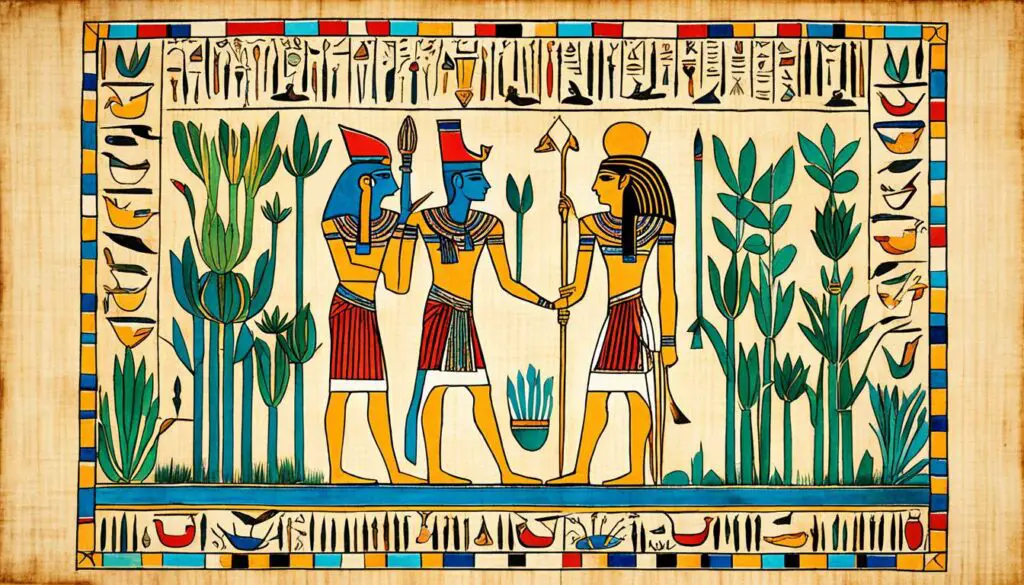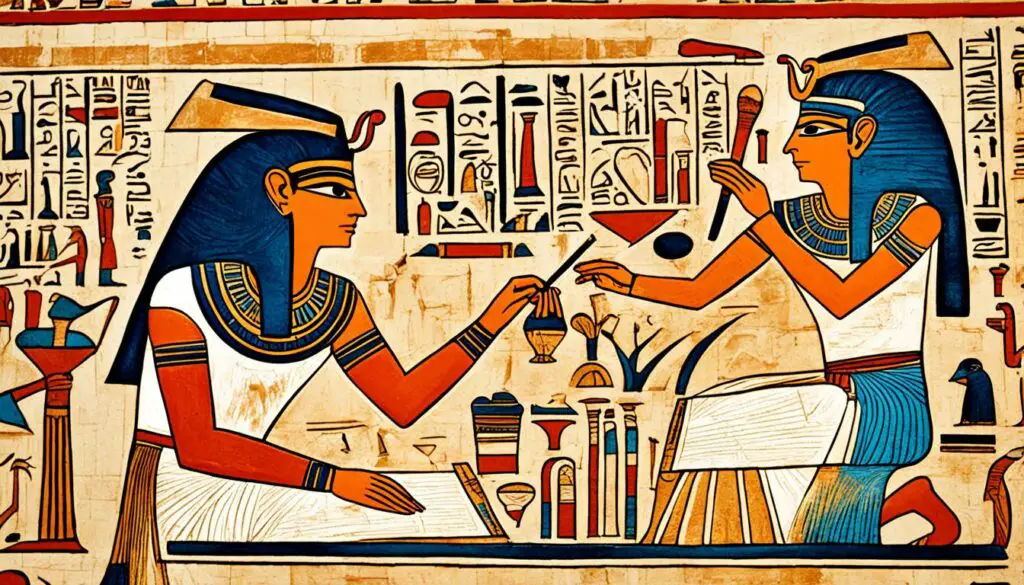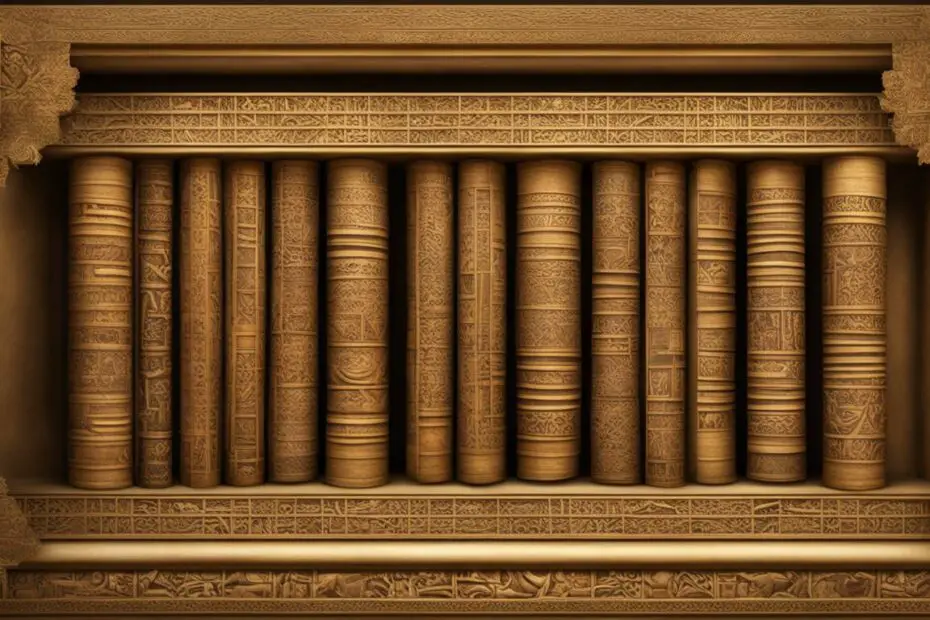Did you know that papyrus played a pivotal role in ancient Egyptian culture? It was more than just a writing material; it was a cultural keystone that influenced art, literature, and daily life. From creating important documents to being used in artwork and everyday items, papyrus was central to the ancient Egyptian civilization.
But what was the significance of papyrus in ancient Egyptian art? How was it used in writing and documentation? And what were the practical uses of papyrus in daily life? Explore the cultural role of papyrus in ancient Egypt and discover its lasting legacy in this article.
The Significance of Papyrus in Ancient Egyptian Art
In ancient Egypt, art held more than just decorative value; it conveyed powerful symbolism and magical qualities. Papyrus, a versatile plant material, played a significant role in artistic representations, serving as a symbol of fertility, protection, and abundance. The ancient Egyptians were renowned for their ability to create visually striking artwork using clean lines, simplified forms, and areas of flat color.
Papyrus, with its rich cultural significance, frequently made its appearance in paintings, sculptures, and murals, highlighting its integral role in Egyptian culture. The use of papyrus in artistic representations served as a visual reminder of the importance it held in various aspects of everyday life.
Artistic representations involving papyrus in ancient Egyptian art frequently showcased its symbolic meanings. As a symbol of fertility, the presence of papyrus in artwork conveyed the idea of growth, prosperity, and the continuation of life. It also symbolized protection, as the thick clusters of papyrus plants along the Nile River provided shelter for birds and small animals.
Additionally, papyrus was associated with abundance and prosperity due to its widespread availability and practical uses in ancient Egyptian society. Its appearance in artwork served to reinforce these positive associations in the minds of the ancient Egyptians.
Despite its simple and unassuming appearance, papyrus played a crucial role in ancient Egyptian art as a symbol of vital concepts and values. Its inclusion in artistic representations served as a visual expression of the deep cultural significance and symbolism associated with this versatile plant material.
Examples of Artistic Representations:
Painting:
- Depictions of papyrus clumps alongside reeds and lotus flowers
- Scenes depicting gods and goddesses standing amidst papyrus plants
Sculpture:
- Statues of deities holding papyrus stalks
- Reliefs featuring papyrus motifs on temple walls
Mural:
- Wall paintings showcasing papyrus plants as part of the natural landscape
- Scenes of daily life activities, such as fishing or boating, incorporating papyrus plants

| Symbolic Meanings of Papyrus in Ancient Egyptian Art | |
|---|---|
| Symbolism | Representation in Art |
| Fertility | Depictions of papyrus clumps alongside reeds and lotus flowers |
| Protection | Scenes of gods and goddesses standing amidst papyrus plants |
| Abundance | Reliefs featuring papyrus motifs on temple walls |
The Use of Papyrus in Writing and Documentation
In ancient Egypt, papyrus played a vital role in the realm of writing and documentation. The ancient Egyptians used this versatile material to create papyrus scrolls, which served as the primary medium for recording and preserving important records.
Papyrus scrolls were instrumental in various aspects of ancient Egyptian society, including religious practices, legal proceedings, historical accounts, and scientific knowledge. These scrolls were utilized to document religious texts, including prayers, rituals, and hymns, which played a central role in ancient Egyptian spirituality.
Legal documents and contracts were also transcribed onto papyrus scrolls, ensuring that the terms and agreements were well-documented and easily accessible. The preservation of historical accounts and chronicles was another significant function of papyrus scrolls, allowing future generations to learn about the triumphs, struggles, and achievements of the past.
Additionally, papyrus scrolls were used to transmit and disseminate scientific knowledge in fields such as medicine, astronomy, and mathematics. Through these scrolls, ancient Egyptian scholars could record their discoveries and share them with others, contributing to the advancement of knowledge and learning.
One of the reasons papyrus scrolls became so widely used in ancient Egypt was their durability, lightweight nature, and ease of transportation. The fibrous composition of papyrus made it resilient and resistant to decay, ensuring the longevity of written records. The lightweight nature of papyrus scrolls made them highly portable, allowing for easy transportation across the vast expanse of ancient Egypt.
To further emphasize the significance of papyrus in writing and documentation, it is important to highlight the example of the famous Egyptian Book of the Dead. This funerary text, which contained spells, prayers, and instructions for the afterlife, was written on papyrus scrolls. It reflects the importance of papyrus and its association with ancient Egyptian beliefs about the afterlife.
Through the utilization of papyrus scrolls, the ancient Egyptians were able to create a vast and comprehensive record of their culture, history, and knowledge. The legacy of their written records on papyrus continues to be a testament to the ingenuity and intellectual achievements of ancient Egyptian society.
Examples of Ancient Egyptian Texts Written on Papyrus
| Text | Description |
|---|---|
| The Book of the Dead | A funerary text containing spells and instructions for the afterlife. |
| The Ebers Papyrus | One of the oldest and most extensive medical texts, containing remedies and treatments. |
| The Rosetta Stone | A decree issued by King Ptolemy V written in three scripts (hieroglyphics, Demotic, and Greek), which proved instrumental in deciphering ancient Egyptian hieroglyphs. |
| The Instructions of Ptahhotep | A moral and instructional text attributed to the vizier Ptahhotep, offering advice on proper conduct and governance. |

Papyrus in Daily Life in Ancient Egypt
Papyrus, with its versatile properties, played an integral role in the everyday lives of ancient Egyptians. Its fibrous nature allowed it to be shaped into various practical items that were essential for their daily activities. From mats to boats, papyrus was utilized in creating everyday items that were both functional and durable.
One of the most common uses of papyrus was in the production of mats. These mats were used to cover the floors of houses, providing a comfortable surface for sitting and sleeping. The Egyptians also weaved baskets from papyrus, which served as containers for storing food, tools, and other essential items. The strong, flexible nature of papyrus made these baskets ideal for carrying heavy loads.

Furthermore, papyrus played a vital role in transportation. The ancient Egyptians constructed boats, known as “papyrus reed boats,” from bundles of papyrus stems tied together. These boats were lightweight, allowing for easy navigation along the Nile River. They were used for fishing, transportation of goods, and even recreational purposes.
The practical uses of papyrus extended to personal items as well. The Egyptians used papyrus to create sandals, which provided protection for their feet while walking on uneven terrains. The fibrous material of papyrus allowed for ventilation, keeping the feet cool in the hot Egyptian climate. Additionally, papyrus was fashioned into fans that provided relief from the scorching sun.
In summary, papyrus was a multifunctional material that was deeply ingrained in the daily life of ancient Egyptians. Its versatility allowed for the creation of mats, baskets, boats, sandals, and fans, catering to various practical needs. The abundance of papyrus along the banks of the Nile River made it easily accessible, making it a valuable resource in ancient Egyptian society.
The Legacy of Papyrus in Ancient Egypt
The cultural influence of papyrus in ancient Egypt left a lasting impact that continues to echo through history. As a versatile material, papyrus played a crucial role in numerous aspects of Egyptian society, leaving behind a profound and enduring legacy.
Papyrus was not simply a writing surface; it symbolized the essence of Egyptian civilization. Its use in writing, art, and everyday items showcased the resourcefulness and creativity of the ancient Egyptians. Papyrus scrolls served as invaluable repositories of knowledge, containing religious texts, legal documents, and historical records that laid the foundation for future written communication.
The enduring symbolism and cultural significance of papyrus can still be seen in modern representations of ancient Egypt. From Hollywood movies to museum exhibits, papyrus is often depicted as the quintessential artifact of the ancient Egyptian legacy. Its portrayal serves as a captivating connection to a rich cultural history that has captivated audiences worldwide.
Today, the legacy of papyrus in ancient Egypt is a testament to the ingenuity of the civilization, reminding us of the invaluable impact of cultural artifacts. The cultural influence of papyrus continues to inspire curiosity, research, and appreciation for the ancient Egyptian legacy, ensuring that its enduring significance will be cherished for generations to come.
FAQ
Q: How was papyrus used in ancient Egyptian culture?
A: Papyrus played a pivotal role in ancient Egyptian culture, serving as a keystone in writing, art, and daily life. It was used for writing important documents, creating artwork, and even as a material for everyday items.
Q: What was the significance of papyrus in ancient Egyptian art?
A: In ancient Egyptian art, papyrus held powerful symbolism as a symbol of fertility, protection, and abundance. It was often depicted in paintings, sculptures, and murals, highlighting its importance in Egyptian culture.
Q: How was papyrus used for writing and documentation in ancient Egypt?
A: Papyrus was used to create scrolls, which served as the primary medium for writing and preserving important records, including religious texts, legal documents, historical accounts, and scientific knowledge. Papyrus scrolls were durable, lightweight, and easy to transport.
Q: What were the practical uses of papyrus in daily life for ancient Egyptians?
A: In daily life, papyrus was used to create mats, baskets, sandals, boats, and other everyday items. Its fibrous nature made it an ideal material for weaving and constructing functional objects.
Q: How did the use of papyrus in ancient Egypt influence subsequent cultures?
A: The use of papyrus as a medium for writing, art, and everyday items influenced subsequent cultures and civilizations. Its significance and symbolism can still be seen in modern depictions and representations of ancient Egypt.
